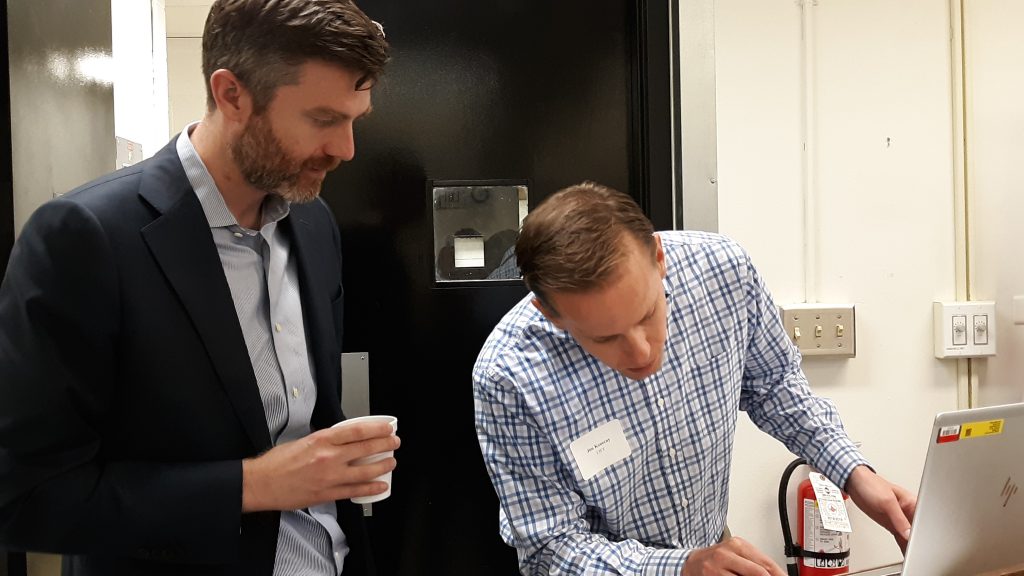By JAN LARSON McLAUGHLIN
BG Independent News
The topic Thursday morning was the 2018 Farm Bill – but outside as more rain fell on the already soaked farm fields, some in the audience had more immediate concerns.
Jonathan McCracken, senior policy adviser to U.S. Senator Sherrod Brown, informed those attending the ag-business forum at the Agricultural Incubator north of Bowling Green that Brown and U.S. Senator Rob Portman were following up on Ohio Gov. Mike DeWine’s request for a disaster declaration for Ohio’s farmers.
“It is not a cure-all by any stretch of the imagination,” McCracken said. But it could help farmers survive.
“This is a historic amount of rain we’ve had,” McCracken said. “Our thought is the USDA has a lot of flexibility” in how to help farmers. And that may include tapping into already approved disaster dollars for places like Puerto Rico, he said.
Normally at this time of year, 98 percent of Ohio’s soybeans are in the ground and all of Ohio’s corn is planted and shoulder high in some cases. But this year, a mere fraction has made it into the ground.
So on Thursday that had farmers asking – Will there be any relief in the cost of crop insurance premiums? And can the USDA help with insurance coverage this year, since most farmers will get about 55 percent of their normal crop producing revenue?
But the big picture at Thursday’s ag-business breakfast was the 1,400-page 2018 Farm Bill, which McCracken tried to condense for the audience. The bill actually covers more than agriculture – with nutrition and forestry also addressed in the policy.
Unlike most other bills, the dividing lines on the farm bill don’t fall along political parties. Instead, the lines are drawn by regions – “commodity politics,” McCracken said.
That pits the Midwest grains against the Southern cotton and peanuts, and both of those against California produce.
“You have all these competing interests,” he said, with politicians looking out for their homegrown products.
“What’s working best for Ohio farmers,” McCracken said of Brown’s motivation. “That’s what he’s there to do.”

The 2018 Farm Bill has three primary focuses – preserving the farm safety net, protecting farmland, and promoting water quality.
The water quality issue reaches further than Lake Erie, he said, to Puget Sound and the “dead” space in the Gulf.
“This water quality issue is not just an Ohio issue,” McCracken said.
The mayor of Defiance, Mike McCann, voiced his concern about the water quality in the three rivers converging in his city.
“A significant number of nutrients flowing into Lake Erie are flowing right through Defiance,” he said.
The city would like to be part of the water quality solution, but needs money and broadband access to do so, the mayor said. Expansion of broadband access is part of the farm bill, and efforts to reduce runoff upriver could reduce the need for Defiance to spend so much on water treatment, McCracken said.
“There’s not a silver bullet to this issue, but there are many silver BBs,” he said.
Some of the other priorities in the farm bill include: no cuts to conservation funding, protections for crop insurance, increased funding for research, and improvements to local food programs.
Conservation programs will be targeted at reducing runoff and protecting water quality, McCracken said.
“Things are always constantly changing in American agriculture,” he said. “It is foolish to think we can just renew the conservation programs as they are and expect different results.”
Other focuses in the farm bill include:
- Explore how to grow more specialty crops in Ohio. That may be as row crops or in greenhouses, where the climate can be controlled. “That’s keeping more of your dollars in the state,” McCracken said.
- Continue support for new younger farmers. The average age of Ohio farmers is 57.
- Create new livestock vaccine programs to combat issues like swine flu.
- Increase research funding, “to make sure America returns to its leadership position in agriculture,” McCracken said.
- Increase access to healthy food in the SNAP program.
- Fund export promotion efforts.
- Expand organic agriculture options.
- Improve programs for dairy farmers.
- Focus on soil health. “Good soil is a good investment,” McCracken said.
- Emphasize cover crops and rotation.
Conservation programs also need to be made more user-friendly for farmers, McCracken said.
“None of the programs work if they aren’t participating,” he said.
An audience member questioned how hemp managed to be included in the 2018 Farm Bill. McCracken explained that hemp is a major commodity of Kentucky farms – the state of Senate Majority Leader Mitch McConnell.
McConnell is a member of the ag committee, but normally doesn’t attend, McCracken said. “He came to a hearing for the first time in 10 years,” he said of the Kentucky senator.

